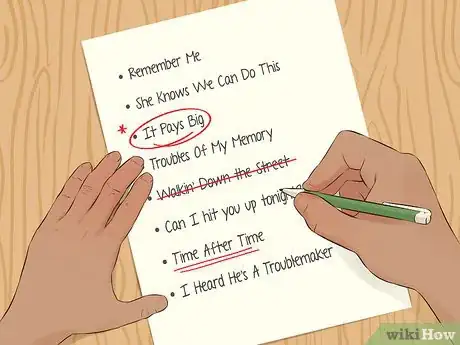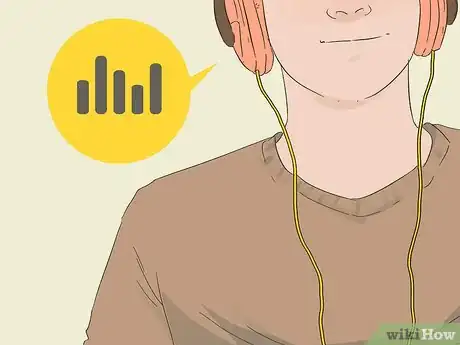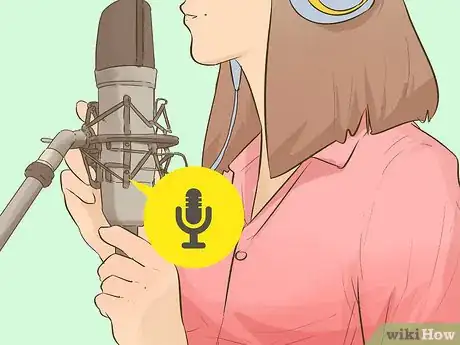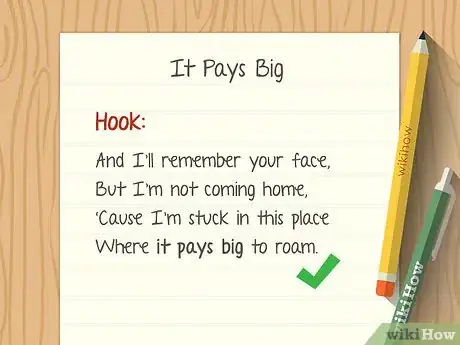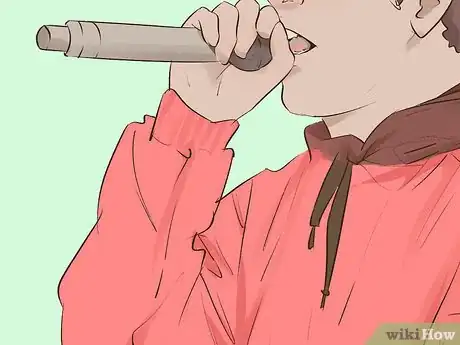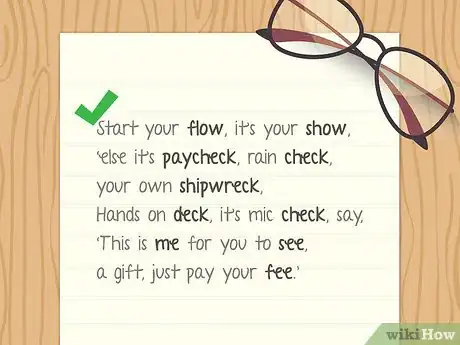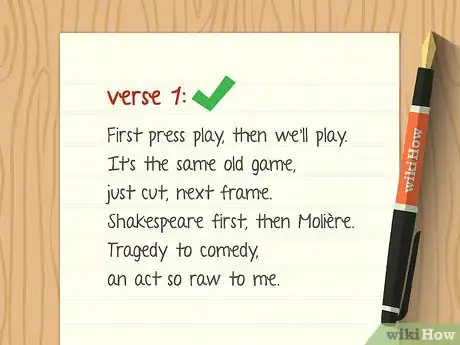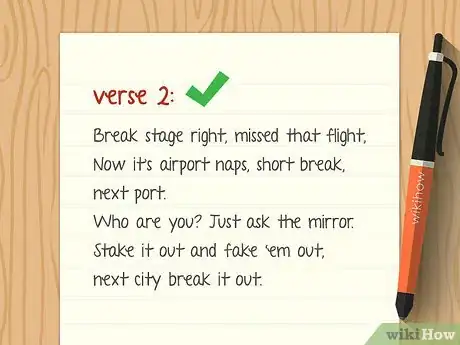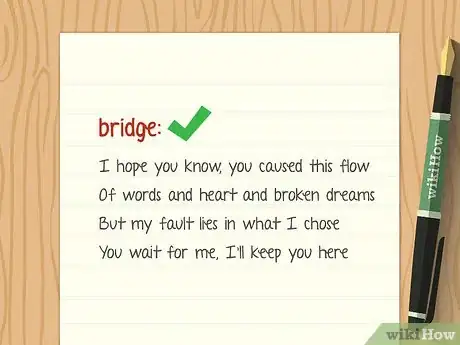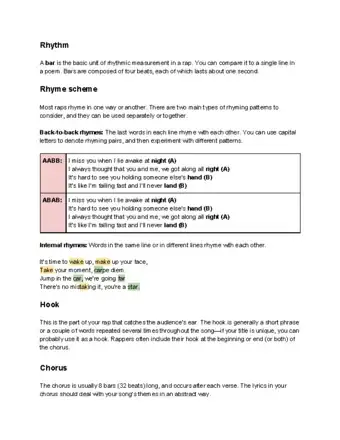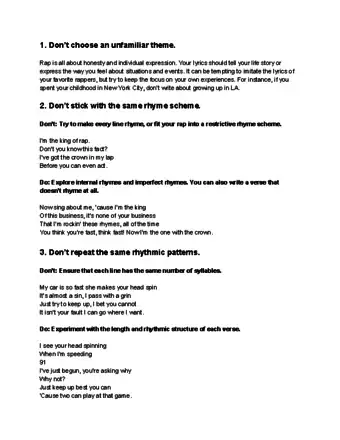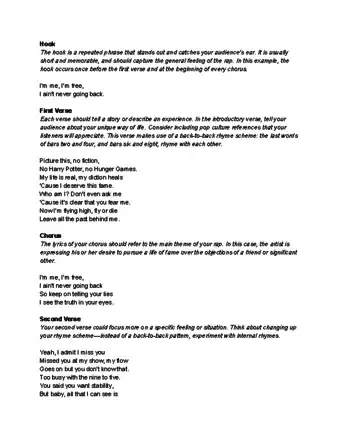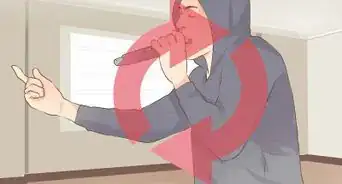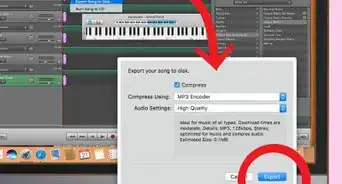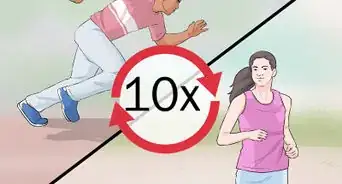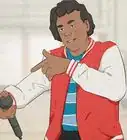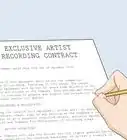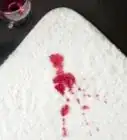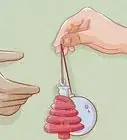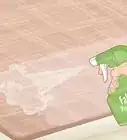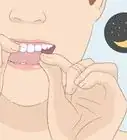This article was co-authored by Tanisha Hall. Tanisha Hall is a Vocal Coach and the Founder and Executive Director of White Hall Arts Academy, Inc. an organization based in Los Angeles, California that offers a multi-level curriculum focused on fundamental skills, technique, composition, theory, artistry, and performance at a conservatory level. Ms. Hall's current and previous students include Galimatias, Sanai Victoria, Ant Clemons, and Paloma Ford. She earned a BA in Music from the Berklee College of Music in 1998 and was a recipient of the Music Business Management Achievement Award.
There are 14 references cited in this article, which can be found at the bottom of the page.
wikiHow marks an article as reader-approved once it receives enough positive feedback. This article received 15 testimonials and 92% of readers who voted found it helpful, earning it our reader-approved status.
This article has been viewed 2,612,695 times.
Rap is, and always has been, about pushing the envelope. Rappers are continuously working to innovate and transcend their audience’s expectations. Lyrics play a huge role in this process, particularly in terms of their emotional rawness, cohesion, and ingenuity. This might sound daunting, but don’t worry! You just need to know how to brainstorm, write a good chorus, and write verses and a bridge to back your chorus up.
Steps
Brainstorming Ideas for Your Lyrics
-
1Use your personal experiences as the inspiration for your lyrics. If you grew up listening to rap, there’s a good chance you’ll be tempted to write about the same things your favorite rappers do. If you had similar life experiences to the ones they had, then great! But, if you didn’t you shouldn’t write about something you don’t know. Write about your own life and tell your own stories. Your audience will appreciate that you’re authentic and honest.[1] [2]
If you’re specific, your listeners might find something to relate to, since they possibly experienced the same events, lived on the same streets, or used the same brands.
-
2Keep a running list of possible song titles. It might sound counterintuitive, but one of the easiest ways to brainstorm lyrics for a song is to come up with possible song titles. Listen for catchy phrases on TV and in movies, and look out for them in books and in real life. You can either use the titles as you hear them, or you can alter them to fit your vision as a songwriter.[5]
- Keep track of your list on your phone or on a notepad so that you don’t forget anything.[6]
Advertisement -
3Find beat tracks you like. Listening to beat tracks can be a great way to brainstorm. Try taking some of your potential song titles and rapping them to different beats. This might help jumpstart a whole chorus or verse without much effort. You can find beat tracks online at sites like RapPad, RawHeatz, and RapBeats .[7] You can also find them on apps like Rap to Beats, Auto Rap, and Rap Chat.[8]
- Some sites and apps may allow you to download beats for free, but many will require a fee to do so.[9]
- Playing around with different beat tracks will also give you an opportunity to scat and improvise to figure out how different lyrics you come up with might fit together.
-
4Record yourself while you improvise a flow. Record yourself on your phone or computer while you improvise a few lyrics. This way you’ll be able to hear how different lyrics sound together, and you won’t forget any of your ideas as you keep writing.[10]
- You should also be sure to write down any lines you come up with while you’re brainstorming. Even if you don’t use them for the song you’re writing, you don’t want to forget them as possible lyrics for later songs.
Writing Your Chorus
-
1Use your potential titles to come up with a hook. The hook is the catchy part of the song that sticks in your head. If your title is memorable, there’s a good chance you can use it as your hook. Because it’s so catchy, you’ll want to repeat your hook as much as possible. So, a lot of songwriters will put their hook at the beginning or end of their chorus, or both.[11]
- The hook to Snoop Dogg’s song “Drop It Like It’s Hot,” for example, is “Drop it like it’s hot,” which is repeated numerous times throughout the song.[12]
- The hook in Cardi B’s song “Bodak Yellow” is “These expensive, these is red bottoms, these is bloody shoes.”[13]
- You don’t necessarily have to use your title to come up with a hook. You can always just play around with different lyrical phrases you’ve come up with that you think might work well.
-
2Experiment with different lyrical rhythms. Most raps are 80 beats per minute (BPM), meaning each beat lasts a little under a second. There are also usually 8 bars in the chorus of a rap with the beat on the quarter note, meaning the chorus will have 32 beats in it. Your lyrical rhythm will depend on the number of words you have in your lyric. If you have 32 words (or a smaller number of words with 32 syllables), you would rap each word or syllable on the beat. If you have 15 words, 14 of them would be on the beat and 2 of them could last 2 beats each or 2 beats and 1 beat each.[14]
- Try using a metronome or a metronome app to keep track of the beat. After you’ve been writing for a while, though, you’ll probably start to internalize the beat.[15]
-
3Try out various rhyming schemes. Making your lines rhyme is a good place to start as a beginner. A lot of raps will rhyme the last word in back-to-back lines or every other line, but you should try experimenting with rhymes that happen in the middle of lines or are multisyllabic.[16]
- Using a rhyming dictionary can be a helpful way of getting you unstuck if you’re struggling to come up with the next line in your rap.[17]
- Once you get the hang of writing rap you should consider mixing it up by not rhyming your lyrics all the time. Making everything rhyme can limit your creativity and interfere with your flow.[18]
Writing the Rest of Your Lyrics
-
1Write your first verse. Rap verses usually have 16 bars, so they’re twice as long as the chorus. The lyrics in the chorus are generally meant to deal with your song’s themes in a vague way, while the lyrics in the verses are meant to provide more specific examples. Think of your verses as telling a story. The first verse should serve as the opening of your story.[19]
-
2Base your second and third verses on the first. After you write your first verse, the next two should come to you pretty easily. The second verse should serve as the middle of your story and the third should serve as your story’s conclusion.[22]
- In the second verse of “It Was a Good Day,” for example, Ice Cube raps about not being bothered by his enemies after rapping about his mom making him breakfast in the first verse.[23]
- Generally, rappers use the same rhythm and rhyme scheme in their second and third verses as in their first, but don’t be afraid to change it up to add something your audience won’t expect.[24]
-
3Add a bridge. The bridge is like a chorus in that it is meant to be vague, but it’s also supposed to add something new to your song lyrically, musically, or both. If you came up with other ideas for hooks in the brainstorming phase, you can use one of them to build your bridge’s lyrics. Then, try playing around with different rhythms, rhyme schemes, and vocal pitches to see what sounds best.[25]
- In the song “Heartless,” for example, Kanye West raps his bridge in a different rhythm and in a higher vocal pitch than the rest of the song.[26]
- If you want to be a professional singer, get a good instructor who can help to get your voice on a professional level.[27]
- Try to connect with the local music community. If there is a local recording studio record with a professional engineer.[28]
- Everybody in your hometown should know you before you try to reach out and take over the world. Sing at every event in your town.[29]
Community Q&A
-
QuestionWhat can I do if my raps don't match the beat?
 Community AnswerFind a new beat, or change some of the endings or the way you introduce a new line. You can even add pauses, which also allows you to catch your breath.
Community AnswerFind a new beat, or change some of the endings or the way you introduce a new line. You can even add pauses, which also allows you to catch your breath. -
QuestionCan a rap be made on the topic "once upon a time"?
 Community AnswerIt depends on the type of mood you want for the music. If you use "once upon a time," the theme of the song probably shouldn't come back to happiness, since you would be reflecting upon something you no longer have. If it is for a sadder song, then it's a great idea.
Community AnswerIt depends on the type of mood you want for the music. If you use "once upon a time," the theme of the song probably shouldn't come back to happiness, since you would be reflecting upon something you no longer have. If it is for a sadder song, then it's a great idea. -
QuestionHow do I not stammer when rapping?
 Community AnswerYou have to really pronounce your words. Open your mouth loud when you rap and if you still stammer then rap slowly and then over time go faster.
Community AnswerYou have to really pronounce your words. Open your mouth loud when you rap and if you still stammer then rap slowly and then over time go faster.
References
- ↑ https://www.musicindustryhowto.com/how-to-write-better-rap-lyrics-5-big-tips/
- ↑ https://www.musicindustryhowto.com/how-to-write-better-rap-lyrics-5-big-tips/
- ↑ https://www.musicindustryhowto.com/how-to-write-better-rap-lyrics-5-big-tips/
- ↑ https://www.musicindustryhowto.com/how-to-write-better-rap-lyrics-5-big-tips/
- ↑ https://mysongcoach.com/write-a-song-in-ten-steps/
- ↑ https://mysongcoach.com/write-a-song-in-ten-steps/
- ↑ https://www.rappad.co/blog/learn-how-to-write-great-rap-lyrics
- ↑ https://www.musicindustryhowto.com/how-to-write-better-rap-lyrics-5-big-tips/
- ↑ https://www.musicindustryhowto.com/how-to-write-better-rap-lyrics-5-big-tips/
- ↑ https://www.connollymusic.com/stringovation/how-to-build-your-improvisation-skills
- ↑ https://www.bmi.com/news/entry/4_dos_and_donts_when_writing_songs
- ↑ https://genius.com/Snoop-dogg-drop-it-like-its-hot-lyrics
- ↑ https://genius.com/Cardi-b-bodak-yellow-lyrics
- ↑ http://colemizestudios.com/how-to-rap-structuring-lyrics/
- ↑ http://colemizestudios.com/how-to-rap-structuring-lyrics/
- ↑ https://www.rappad.co/blog/learn-how-to-write-great-rap-lyrics
- ↑ https://www.rappad.co/blog/learn-how-to-write-great-rap-lyrics
- ↑ https://www.musicindustryhowto.com/do-lyrics-have-to-rhyme-common-myths-broken-down/
- ↑ https://www.musicindustryhowto.com/how-to-write-better-rap-lyrics-5-big-tips/
- ↑ https://genius.com/Jay-z-99-problems-lyrics
- ↑ https://www.musicindustryhowto.com/how-to-write-better-rap-lyrics-5-big-tips/
- ↑ https://www.musicindustryhowto.com/how-to-write-better-rap-lyrics-5-big-tips/
- ↑ https://genius.com/Ice-cube-it-was-a-good-day-lyrics
- ↑ https://www.musicindustryhowto.com/how-to-write-better-rap-lyrics-5-big-tips/
- ↑ https://www.bmi.com/news/entry/to_bridge_or_not_to_bridge_and_other_songwriting_questions1
- ↑ https://genius.com/Kanye-west-heartless-lyrics
- ↑ https://bestaccreditedcolleges.org/articles/become-a-professional-singer-education-and-career-roadmap.html
- ↑ https://bestaccreditedcolleges.org/articles/become-a-professional-singer-education-and-career-roadmap.html
- ↑ https://bestaccreditedcolleges.org/articles/become-a-professional-singer-education-and-career-roadmap.html
About This Article
To write rap lyrics, try using personal experiences you've had as the inspiration for your lyrics, like by thinking about the street you grew up in or the city where you lived. Additionally, try listening to several beat tracks for inspiration. Once you've got a few ideas, record yourself improvising some lyrics on your phone so you can hear how they sound. You should also experiment with the rhyme structure, such as by trying to make one line after the other rhyme, or by testing out rhyming lyrics in the middle of a line. For tips on how to create a hook and how to write a chorus, read on!

